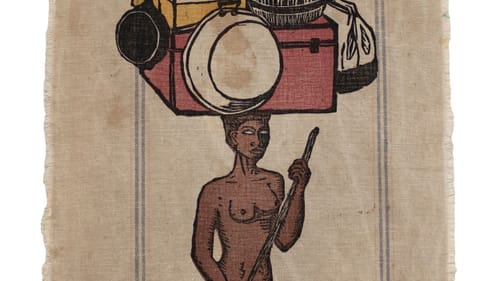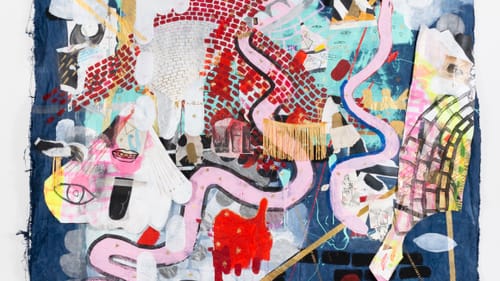Stay in the Loop
BSR publishes on a weekly schedule, with an email newsletter every Wednesday and Thursday morning. There’s no paywall, and subscribing is always free.
Trash to treasure
Arthur Ross Gallery presents ‘Re-materialize’

In Troilus and Cressida, Shakespeare provides a fair description of 21st-century post-consumer waste: “Those scraps are good deeds past; which are devour’d as fast as they are made, forgot as soon as done.” Unless the scraps fall into the hands of an artist like El Anatsui, Shari Mendelson, Jackie Milad, or Alison Saar, of Arthur Ross Gallery’s (ARG) new digitally accessible exhibition, Re-materialize.
They redeploy what the less imaginative drag to the curb, consign to charity, and stuff into attics. In works replete with reborn bottle caps and bailing wire, repurposed sugar sacks and linen handkerchiefs, salvaged souvenirs, and reinvented plastic bottles, Re-materialize spotlights the practice of these repurposing artists.
Originally scheduled for spring 2020, the show opened in September when operation resumed at the gallery, located on the University of Pennsylvania campus. A mobile tour developed by curator Heather Moqtaderi can substitute for or supplement in-person viewing. It consists of audio commentary, artist biographies, and in-studio videos. In addition, recent live conversations with Mendelson and Milad are archived on the gallery site.
Plastic artifacts
Plastic bottles are useful only as long as it takes to chug a beverage, but as trash, they’re eternal. Shari Mendelson doubles down on that irony, replicating ancient artifacts with discards she collects in her Brooklyn neighborhood.
Just as Rumpelstiltskin spun gold from straw, Mendelson makes vessels that appear to have held liquids considerably more interesting than water or soda. A six-minute video shows her cutting, shaping, and hot gluing to achieve the form and patina of Phoenician or Roman glass. Lynn Marsden-Atlass, ARG executive director, compares the process to alchemy, and the results are magical.
Mendelson’s sculpture of plastic, resin, acrylic, and mica, Double Deer with Cup (2009), appears to be made of alabaster. Two deer merge to form a shelf for a cup, their antlers branching majestically. Crouching Sphinx (2020) has a blue-white patina and a slender tail that arches over its back. Imagine it gracing a table in Pompeii.
In harm’s way
Instead of modern trash, mixed-media sculptor Alison Saar pokes into old trunks, tag sales, and forgotten corners, looking for objects with a history, such as well-worn quilts, seed sacks velvety with use, scratched wash basins, and rusty buckets: trappings of everyday life with which she preserves the African American past.

The print Breach (2017) recalls a cataclysmic flood on the Mississippi in 1927. Black sharecroppers were enlisted to build levees, which became cut off from the mainland as waters rose. Instead of evacuating them, local leaders made sharecroppers remain, protecting surrounding farmland. Saar compares the forced sequestration to a concentration camp, and depicts the predicament in the figure of a Black woman, standing on a raft no larger than a doormat, poling through the water, with her worldly possessions, trunks, frying pans—even a rocking chair—balanced on her head, a cruel crown for an unjust life. Saar printed the image on vintage grain and seed sacks, the kind that would have been filled with sand to reinforce levees.
“It struck me how little had changed from the 1927 flood to the Katrina flood, and how…African American[s] and people of color…[and] the poor were always put in harms way,” Saar comments in a 2016 video.
In High Yella’ Blue (2016) and Redbone Blues (2017), she examines derogatory terms for people of mixed racial heritage. Linen handkerchiefs bear imprints of a woman (High Yella’) and a man (Redbone). Black Bottom Stomp (2017) references the 20th century’s Great Northern Migration, when African Americans fled the agricultural south for the industrial north, bringing with them a rich musical tradition of blues and jazz.
High-touch works
“I’m constantly looking for anything that has that connection to human hands in a meaningful way,” El Anatsui has said, an intention reflected in his materials and how they are manipulated into finished pieces.
The silvery-orange wall hanging Sacred Moon (2007) is huge—8 ½ by 11 feet—and evokes stamped Adinkra and woven Kente fabrics of Anatsui’s native Ghana. Though flexible as fabric, Sacred Moon is made of aluminum: row after row of folded strips, bound with copper wire: a massive, tedious undertaking. Even in a still photo, the massive work appears to flutter.
Anatsui, who lives in Nigeria, is known for large-scale sculptures inspired by African tradition and culture. Liquor bottle caps, a favored material, acknowledge European influences on the continent. The artist’s labor-intensive pieces require many hands to fabricate and install. Moqtaderi told Penn Today that Anatsui “wants curators to put their own creative touch on each installation. It was a bit intimidating, but our art handlers pushed and pulled the metal fabric in different directions until it seemed just right, and they nailed it into place. It’s a lot of responsibility, and it was a magical experience to collaborate with the artist in this way.”
Amalgamations
Jackie Milad repurposes symbols of her own heritage. The Egyptian-Honduran-American artist works on paper, canvas, and in collage in a style Moqutaderi compares to graffiti, in which “layers of imagery are added, erased, and painted over again and again.”

Imagine graffiti set to pulsing music and you get Yalla Simsim, a lightning-paced video by Milad and Tom Boram. The central image, a spinning, ever-mutating pyramid, releases a maelstrom of film clips, abstract graphics, quick-change iconography, and colloquial phrases, pulverizing the stereotype of Ancient Egypt.
In a 2019 interview, Milad described early influences, including relatives’ homes adorned with “pyramids, papyrus paintings, busts of pharaohs, evil eye trinkets, and religious items such as Coptic crosses and pictures of saints.” On the side of her Honduran family, there were “a variety of Honduran handicrafts, Santeria candles, and Catholic crosses… All these symbols of culture collapsing on top of one another.” That’s a familiar sensation to Milad, a multiracial, multiethnic child of immigrants: “an amalgamation.”
Openings in the Wall (2020), an abstract work, employs familiar symbols. Wall fragments float across the hand-dyed canvas, as do eyes, most of them blank. There’s a tiny pharaoh and a little sarcophagus in the mix, as well as a flashlight and a bullet. Diagonal lines angle in toward the center, streams of light or maybe, access shafts. A giant pink asp winds through it all, finding its way.
Image description: Crouching Sphinx, a sculpture made out of the material of discarded plastic bottles, by Shari Mendelson. It looks like a small, graceful Sphinx with a teacup balanced on its head. It has a waxy, marbled texture, and its main color is white, with hints of blue and bronze throughout.
Image description: Breach, a print by the artist Alison Saar. The image shows a naked Black woman standing on a small raft on brown water. There’s a pile of things balanced on her head, including trunks, a barrel, pans, and a rocking chair. The pile is larger than her own body. The colors in the pile are faded red, yellow, green, and blue.
Image description: Openings in the Wall, a multimedia collage by artist Jackie Milad. It’s large and square. It has many bold lines, shapes, and outlines overlapping throughout, in pink, blue, orange, red, black, and yellow. Some shapes evoke brick walls, eyes, mouths, and a snake.
What, When, Where
Re-materialize. Through December 20, 2020, at Arthur Ross Gallery, University of Pennsylvania Fisher Fine Arts Building, 220 South 34th St., Philadelphia. (215) 898-2083 or ArthurRossGallery.com.
ARG’s mobile tour application is compatible with phone accessibility features, including screen readers and dynamic text.
ARG is in the process of uploading audio alternative-text image descriptions, and transcriptions of mobile tour audio for hearing impaired visitors.
Online events are closed-captioned through live automated captioning. Captioned videos are posted to the ARG virtual programs page after each event.
Sign up for our newsletter
All of the week's new articles, all in one place. Sign up for the free weekly BSR newsletters, and don't miss a conversation.
